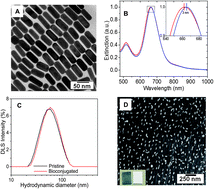Biomimetic SERS substrate: peptide recognition elements for highly selective chemical detection in chemically complex media†
Abstract
Surface enhanced Raman scattering (SERS) is rapidly emerging as a sensitive transduction platform for the trace detection of chemical and biological analytes. A critical challenge that needs to be addressed to propel this technique into real world applications is the poor chemical selectivity of the existing SERS substrates. In this communication, we demonstrate a novel biomimetic approach to enhance the selectivity of plasmonic nanostructures to target chemical analytes. In particular, we demonstrate that material-binding peptides, identified through phage-display, serve as recognition elements for selective capture of target chemical species from a complex chemical mixture. As a proof of concept, we show that a nitroaromatic explosive molecule, trinitrotoluene (TNT), can be detected down to 100 pM concentration even in a complex organic chemical mixture. This ultrasensitive and selective detection is enabled by TNT-binding peptides appended to gold nanorods, which serve as selective SERS media. To the best of our knowledge, this is the first demonstration of a biomimetic SERS substrate facilitating selective and sensitive detection of a target chemical analyte in the presence of numerous unknown interfering species.


 Please wait while we load your content...
Please wait while we load your content...